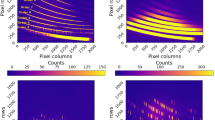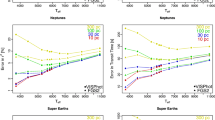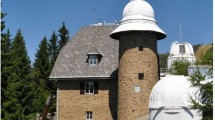Abstract
The photometric accuracy in the near-infrared (NIR) wavelength range (0.9–2.6 \(\mu\)m) is strongly affected by the variability of atmospheric transmission. The Infrared Working Group (IRWG) has recommended filters that help alleviate this issue and provide a common standard of NIR filtersets across different observatories. However, accurate implementation of these filters are yet to be available to astronomers. In the meantime, InGaAs based detectors have emerged as a viable option for small and medium telescopes. The present work explores the combination of IRWG filtersets with InGaAs detectors. A few commercially available filtersets that approximate the IRWG profile are compared. Design of more accurate IRWG filtersets suitable for the InGaAs sensitivity range is undertaken using an open-source filter design software – OpenFilters. Along with the photometric filters iZ, iJ and iH, design of a few useful narrow band filters is also presented. These filters present opportunities for small and medium telescopes for dedicated long-term observation of interesting infrared sources.







Similar content being viewed by others
References
Ananthasubramanian P. G., Yamamoto S., Prabhu T. P., Angchuk D. 2004, Bull. Astr. Soc. India 32, 99
Bass M. 2010, Handbook of Optics: Volume V Atmospheric Optics, Modulators, Fiber Optics, X-Ray and Neutron Optics (McGraw-Hill Education)
Chen Y., Hahner D., Trubetskov M., et al. 2020 Appl. Phys. B 126, 1
Coelho P. R. T. 2014, International Workshop on Stellar Spectral Libraries, 11, 57
Henden A. A. 2002, JAAVSO, 31, 11
Johnson H. L. 1965 The Astrophysical Journal, 141, 923
Johnson H. L., Mitchell R. I., Iriarte B., Wisniewski W. Z. 1966, Communications of the lunar and planetary laboratory, 4, 99
Koo B. C., Raymond J. C., Kim H. J. 2016, Journal of Korean Astronomical Society, 49, 109
Larouche S., Martinu L. 2008, Appl. Opt. 47, 219
Lord S. D. 1992, Ames Research Center 103957, 1
Manduca A., Bell R. A. 1979 Publications of the Astronomical Society of the Pacific, 91, 848
Milone E. F., Young A. T. 2005, Publications of the Astronomical Society of the Pacific, 117, 485
Milone E. F., Young, A. T. 2007, Standardization and the Enhancement of Infrared Precision. In The Future of Photometric, Spectrophotometric and Polarimetric Standardization Vol 364, p 387
Milone E. F., Young A. T. 2008, Infrared passbands for precise photometry of variable stars by amateur and professional astronomers, arXiv preprint arXiv:0805—b
Milone E. F., Young A. T. 2011, Infrared Photometry for Automated Telescopes: Passband Selection in Telescopes from AFAR Conference, Waikaloa, HI
Mishra A. K., Kamath U. S. 2021, J. Opt. 1
Mishra A. K., Kamath U. S. 2021, J. Astrophys. Astron. 42, 11
Ningombam S. S., Jade S., Shrungeshwara T. S., Song H. J. 2016, Journal of Atmospheric and Solar-Terrestrial Physics, 137, 76
Richter H., Wood P. R., Woitke P., Bolick U., Sedlmayr E. 2003, Astronomy & Astrophysics, 400, 319
Rodrigo C., Solano E., Bayo A. 2012, SVO Filter Profile Service Version 1.0. IVOA Working Draft, 15
Rodrigo C., Solano E. 2020, The SVO Filter Profile Service. In Contributions to the XIV.0 Scientific Meeting (virtual) of the Spanish Astronomical Society, p 182
Sakiew W., Schrameyer S., Schwerdtner P., Erhart N., Starke K. 2020 Appl. Opt. 59, 4296
Stephens D. C., Leggett S. K. 2003, Publications of the Astronomical Society of the Pacific, 116, p 9
Sullivan P. W., Croll B., Simcoe R. A. 2014, Near-infrared InGaAs detectors for background-limited imaging and photometry. In High Energy, Optical, and Infrared Detectors for Astronomy VI (Vol 9154, p 91541F). International Society for Optics and Photonics
Tokunaga A. T., Vacca W. D., Young E. T. 2013, Infrared Astronomy Fundamentals. Planets, Stars and Stellar Systems, Vol 2, Astronomical Techniques, Software and Data, p 99
Vermeiren J. P., Merken P. 2017, November, InGaAs detectors and FPA’s for a large span of applications: design and material considerations. In International Conference on Space Optics–ICSO 2014, International Society for Optics and Photonics, 10563, p 1056313
White N. M., Wing R. F. 1978, The Astrophysical Journal, 222, 209
Wing R. F., Milone E. F., Sterken C. 2011, Astronomical Photometry–Past, Present and Future, Vol 373, Springer Science & Business Media
Yurchenko S. N., Tennyson J., Bailey J., Hollis M. D., Tinetti G. 2014, Proceedings of the National Academy of Sciences, 111, 9379
Zombeck M. V. 2006, Handbook of space astronomy and astrophysics. Cambridge University Press
Acknowledgments
The authors have made use of the WebPlotDigitizer tools to digitize data (https://automeris.io/WebPlotDigitizer). This research has made use of the SVO Filter Profile Service (http://svo2.cab.inta-csic.es/theory/fps/) supported from the Spanish MINECO through grant AYA2017-84089 (Rodrigo et al. 2012; Rodrigo & Solano 2020).
Author information
Authors and Affiliations
Corresponding author
Appendices
Appendix A. Methods for SNR calculation
Collected flux in Watts from a star is specified as:
where \(A_{\mathrm{eff}}\) is the effective collecting area of the telescope, \(F_{\mathrm{BW}}\) is the filter bandwidth in nm, \(\Phi _\mathrm{zero}\) is the flux from a zeroth magnitude star in W/\(\hbox {m}^2\)/nm and \(m_{*}\) is the magnitude of the star.
\(F_{\mathrm{BW}}\) and \(m_{*}\) are known parameters and \(\Phi _{\mathrm{zero}}\) is collected from Zombeck (2006). The effective collecting area, \(A_{\mathrm{eff}}\) for a telescope is:
where D is the telescope diameter, a is a factor corresponding to secondary obstruction; nominally 0.85 and b is the throughput; nominally 0.2.
Using these parameters, the SNR for single pixel detectors can be calculated as:
where \(P_c\) is incident energy in Watts, NEP is noise equivalent power of the detector in Watts/\(\sqrt{\mathrm{Hz}}\) and \(T_{i}\) is the on-source integration time.
SNR for array based detectors:
where \(N_{\mathrm{dark}}\) is the dark current of the detector given in \(\hbox {e}^-\)/pixel/S, \(N_{\mathrm{read}}\) is the read noise of the detector given in \(\hbox {e}^-\)/pixel, \(p_n\) is the number of pixels used to sample the stellar disk; nominally 16 and \(T_{i}\) is the on-source integration time.
Using these relations between the desired SNR and time of integration, minimum integration time for \({\mathrm{SNR}} = 100\) for various filter and detector combinations are given in Table 2.
Appendix B. Filter transform between IRWG and Johnson filters
For the present typical achievable photometric accuracies in NIR (Milone & Young 2007; Wing et al. 2011), i.e., 3–5%, filter transforms between different implementations of the IRWG filterset may not be required. For more accurate photometry, i.e., 1% or lower, just 57 bright standards may not be sufficient for an exact transformation. We have included the synthetic photometric data of all 57 MaunaKea primary stars in various filtersets considered, should there be interest for such transforms. The data are included in Table 5 as a list of magnitudes. A rudimentary transform fit between IRWG and the Johnson filterset derived from the 57 MaunaKea standards is also included in Figure 9. For various aspects of filter transforms of IRWG filtersets, the work done by Milone & Young (2005) is to be referred
In (a) the degradation of the filter profile due to introduction of random errors in layer thickness is shown. Errors within 0.5–1.5% maybe tolerated without significant degradation of transmission. In (b) the shortward shift of the profile is shown with increase in incidence angle. For incidence angles upto 8\(^\circ\), the resulting change in transmission is minimal and within the allowable range. The atmospheric transmission window is shown in the background to demonstrate this. For large incidence angles (e.g., larger field of view) a slightly different approach to optimization may be taken (see text).
Rights and permissions
About this article
Cite this article
Mishra, A.K., Kamath, U.S. Filters for NIR astronomical photometry: comparison of commercial IRWG filters and designs using OpenFilters. J Astrophys Astron 43, 13 (2022). https://doi.org/10.1007/s12036-021-09788-2
Received:
Accepted:
Published:
DOI: https://doi.org/10.1007/s12036-021-09788-2






